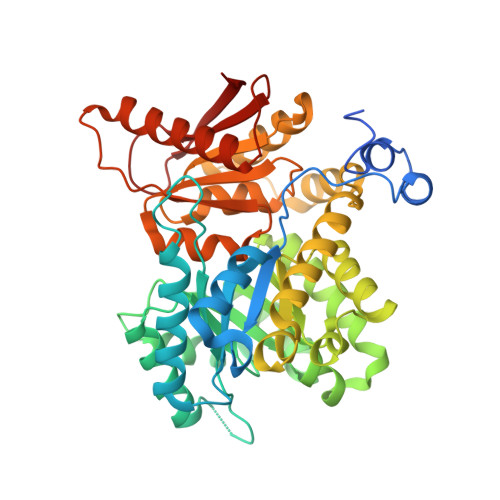Tuning liver pyruvate kinase activity up or down with a new class of allosteric modulators.
Nain-Perez, A., Nilsson, O., Lulla, A., Haversen, L., Brear, P., Liljenberg, S., Hyvonen, M., Boren, J., Grotli, M.(2023) Eur J Med Chem 250: 115177-115177
- PubMed: 36753880
- DOI: https://doi.org/10.1016/j.ejmech.2023.115177
- Primary Citation of Related Structures:
7FRV, 7FRW, 7FRX, 7FRY, 7FRZ, 7FS0, 7FS1, 7FS2, 7FS3, 7FS4, 7FS5, 7FS6, 7FS7, 7FS8, 7FS9, 7FSA, 7FSB, 7FSC, 7FSD - PubMed Abstract:
The liver isoform of pyruvate kinase (PKL) has gained interest due to its potential capacity to regulate fatty acid synthesis involved in the progression of non-alcoholic fatty liver disease (NAFLD). Here we describe a novel series of PKL modulators that can either activate or inhibit the enzyme allosterically, from a cryptic site at the interface of two protomers in the tetrameric enzyme. Starting from urolithin D, we designed and synthesised 42 new compounds. The effect of these compounds on PKL enzymatic activity was assessed after incubation with cell lysates obtained from a liver cell line. Pronounced activation of PKL activity, up to 3.8-fold, was observed for several compounds at 10 μM, while other compounds were prominent PKL inhibitors reducing its activity to 81% at best. A structure-activity relationship identified linear-shaped sulfone-sulfonamides as activators and non-linear compounds as inhibitors. Crystal structures revealed the conformations of these modulators, which were used as a reference for designing new modulators.
Organizational Affiliation:
Department of Chemistry and Molecular Biology, University of Gothenburg, SE-412 96, Gothenburg, Sweden.



















